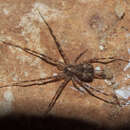en
names in breadcrumbs


The essentially tropical and subtropical spider family Hersiliidae (two-tailed or longspinneret spiders) includes 176 described species (Platnick 2013), just two of which occur in North America north of Mexico, both of them poorly known: Neotama mexicana in extreme southern Texas and Yabisi habanensis in extreme southern Florida (Cutler 2005; Bradley 2013).
Hersiliids share a distinctive morphology. The body is dorsoventrally (i.e., top to bottom)flattened with the ocular area raised; the posterior lateral (side) spinnerets are extremely long, as long or longer than the abdomen; there are a series of seta-like spigots along the medial (inner) side of the spinnerets; and the legs are very long and slender.
Hersiliids capture prey by holding their spinnerets over the prey and rapidly circling and swathing them with silk. Some hersiliids are known to live on tree trunks where they rest on silken mats, frequently camouflaged by mosses and lichens. Other species are known from stone fields, where they build irregular webs under rocks. Camouflaged egg sacs are attached to tree limbs or under rocks.
(Rheims and Brescovit 2004; Cutler 2005)